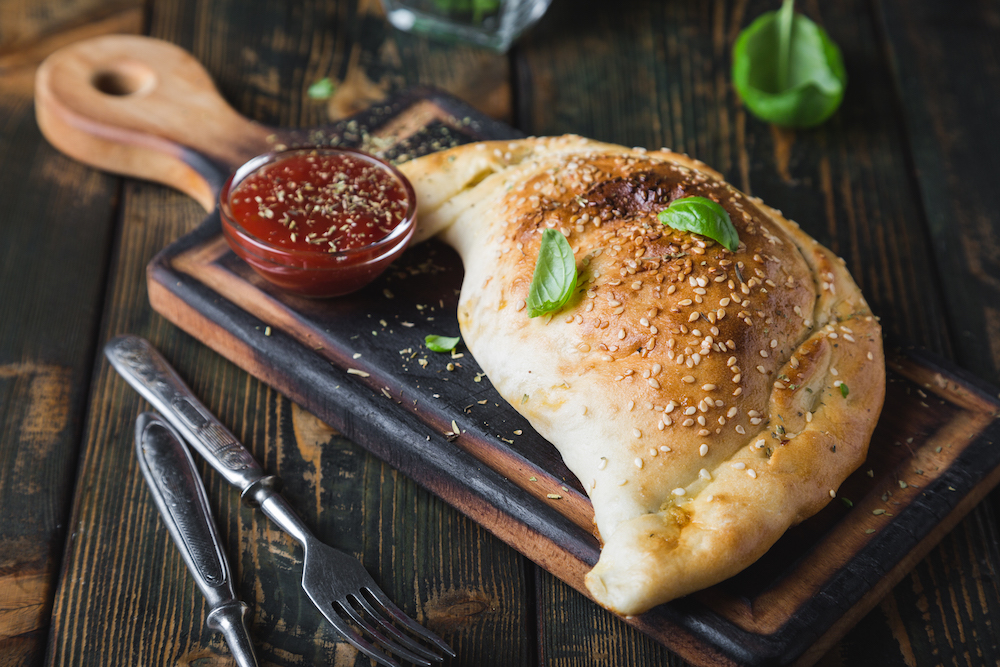- Ready to usher your customers into the Calzone Zone? You’ll want to use a dough that’s specifically formulated for that purpose.
- For a nice, tender calzone dough, use a lower-protein, bread-type flour with a protein content in the range of 10.8% to 11.6%.
Related: 8 tips for selling more soups during the wintertime
Most pizzerias serve some type of calzone, typically using their regular pizza dough folded over the filling. Some chefs brush it with egg wash to enhance the crust color, but it’s more commonly brushed with oil or melted butter and finished with a shake of Italian seasoning and a little powdered Parmesan cheese.
But if you want to take your pizzeria’s calzones to the next level, you should try using a dough specifically formulated for that purpose. To enhance the overall quality of the calzone, try using a calzone dough that’s more like pastry than just a folded-over pizza. When you look at similar products from other cultures, you might see the Patty Pie from Jamaica or the Empanada from Latin America—both are examples of filled products made from a dedicated pastry-like dough.
To achieve a tender characteristic in your calzone dough, a lower-protein, bread-type flour should be used. Look for a flour with a protein content in the range of 10.8% to 11.6% to achieve a tender crust while still providing good dough-handling properties.
Here is a starting point for a dough formulation that, by itself, makes a very good calzone. It can also be modified to suit specific needs or dough management procedures.
Flour: 100%
Salt: 1.75%
Sugar: 4%
Liquid whole egg (optional): 5% or dry, powdered whole egg can be substituted at 1.25%. (Note: For food safety reasons, use frozen, pasteurized liquid whole egg as opposed to shell eggs.)
Fat (butter or margarine): 5%
Instant dry yeast: 0.6% or compressed yeast at 1.5% or active dry yeast (ADY) at 0.75% (hydrate the ADY in 100-degree water for 10 minutes before using)
Water: 53% with 5% liquid whole egg or 56% with dry whole egg powder. (Water temperature should be adjusted to give a finished dough temperature in the range of 70° to 75° degrees. This normally requires a water temperature of about 70 degrees.)
Related: Try these easy calzone recipes from Giordano’s
Calzone Dough-Making Procedure:
Add the water to the mixing bowl first. Then add the salt, sugar and liquid whole egg. If dry whole egg is used, it must be added with the flour.
Add the flour and put the yeast and dry whole egg (if used) on top of the flour. Mix for 1 minute at low speed. Add the butter/margarine and mix for 1 additional minute at low speed. Change to second/medium speed and mix the dough just until it takes on a smooth appearance.
Target finished dough temperature: 80 to 85 degrees F.
Take the dough directly to the bench for scaling and balling. Place your dough balls into plastic dough boxes/trays. Oil the top of each dough ball and take directly to the cooler.
Cross-stack the boxes of dough in the cooler for 2.5 hours, then down-stack, nesting or lidding the boxes to prevent drying. Allow the dough to cold-ferment in the cooler for 24 to 36 hours before use. Dough may be kept in the cooler for up to 48 hours.
To use the dough, remove about a three-hour supply of dough balls from the cooler and place at room temperature. Allow the dough to temper to 50° before using it. You will need to experiment to see how long this will take in your shop.
Once the dough balls have reached 50°, they are ready to be used in making your calzones.
Open the dough balls by your preferred method. However, pressing is not recommended; the oil required for pressing is not conducive to achieving a satisfactory seal on the seam that holds the dough closed during baking.
Place the opened dough skin on the bench and begin adding the fillings. Try adding a 50/50 mix of mozzarella and ricotta cheese, although 100% mozzarella or 100% ricotta can be used. (Mozzarella and feta works well for a Greek-themed calzone). Add your sauce, whether it’s pizza sauce, alfredo sauce, or pesto. Add the desired fillings and fold the uncovered portion of the dough over the portion with the filling. The edges should be lined up and crimped tightly together to form a tight seam seal. This can be accomplished using your fingers, but some prefer to use the tines of a fork.
Carefully transfer the calzone to a pizza screen. Brush the top of each calzone with heavy cream, whole milk, melted butter or olive oil to enhance crust color. Using scissors, cut several delta “V-shape” slits into the top of each calzone before baking.
For a flavor boost, try sprinkling the top of each calzone with shredded Parmesan cheese just before baking. The toasted cheese adds both flavor and eye appeal to the finished calzone.
Bake the calzones in a deck oven at about 450° until golden-brown. If you’re using an air impingement oven, the baking temperature will be about 400°.
Note: Due to the differences in air impingement ovens and the different airflow profiles employed, you may need to experiment with baking times and temperature to find what works best in your specific oven. In rare cases, you may find it necessary to change the top and/or bottom finger profiles to achieve the best bake.
When the calzone comes out of the oven, many operators like to brush them with melted butter or olive oil and serve. You might want to sprinkle the top of each calzone with a mixture of Italian seasonings and grated/powdered Parmesan cheese.
As you will see, these are not your “run-of-the-mill” calzones. The crust is soft and tender, more like that of a pastry than a pizza, and full of great flavor. Let your imagination run wild in coming up with different fillings. Just remember not to use any raw meat products in your calzones.
Want to try a breakfast calzone? Some interesting fillings include precooked crispy bacon, retort scrambled eggs, breakfast sausage crumbles, precooked potatoes (dehydrated potato slices work great in this application), diced ham, fresh tomato, sautéed onion and green peppers.
Taking the calzone to the next level can certainly add to your bottom line, or it can be the basis for your new restaurant. Want a catchy name for it? How about “The Calzone Zone”?
Before he passed in December 2020, Tom Lehmann was a longtime contributor to PMQ Pizza Magazine and served as the director of bakery assistance for the American Institute of Baking.















